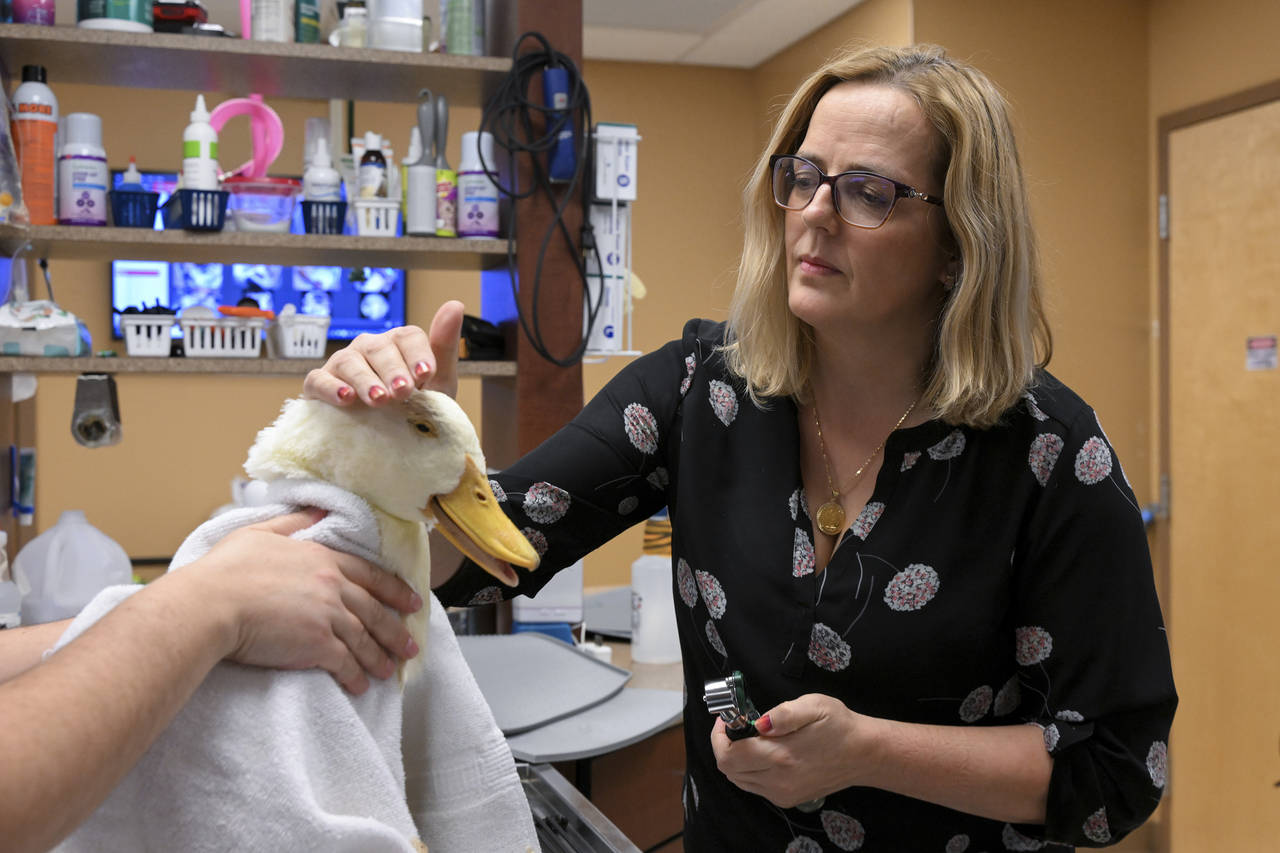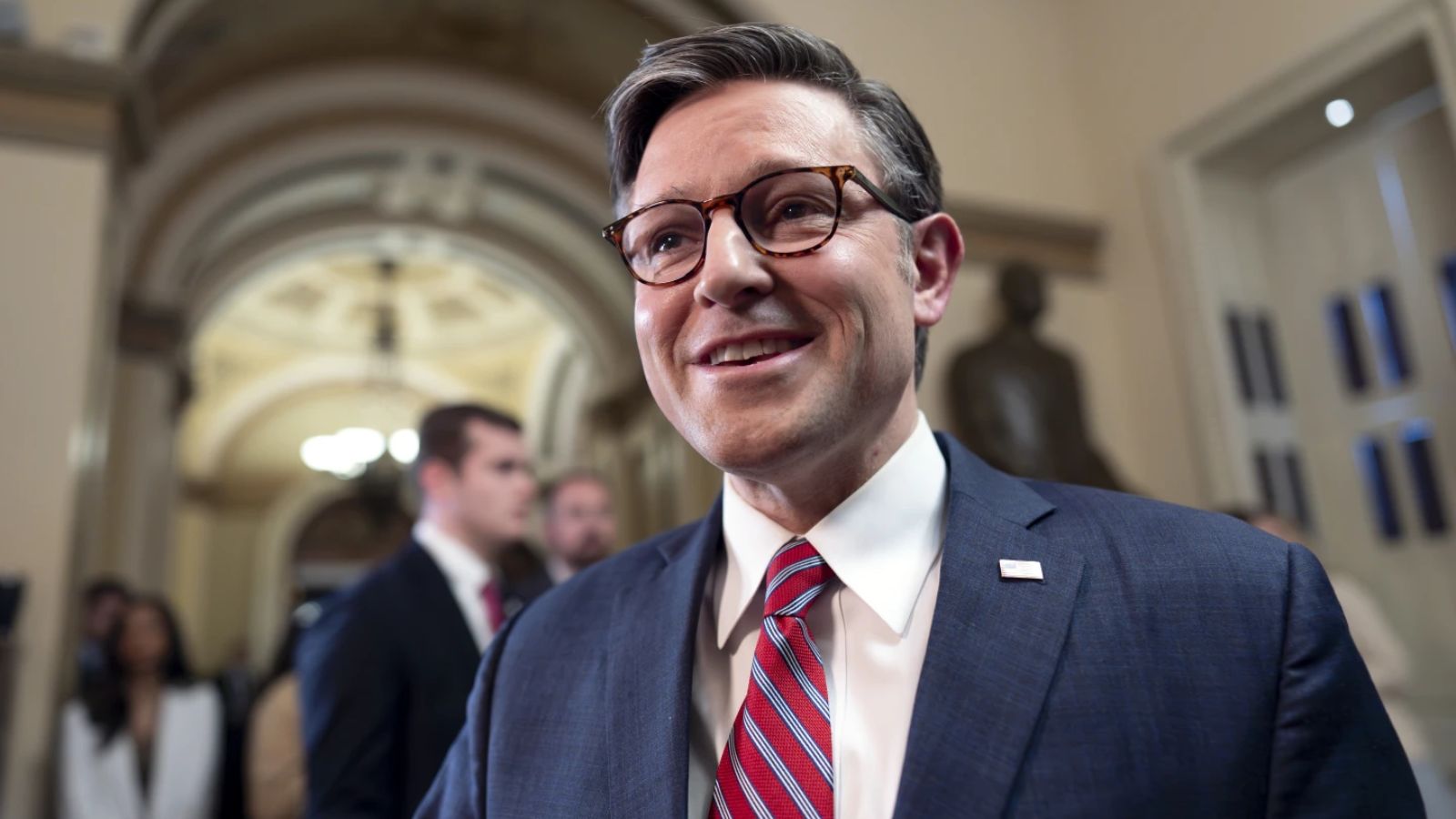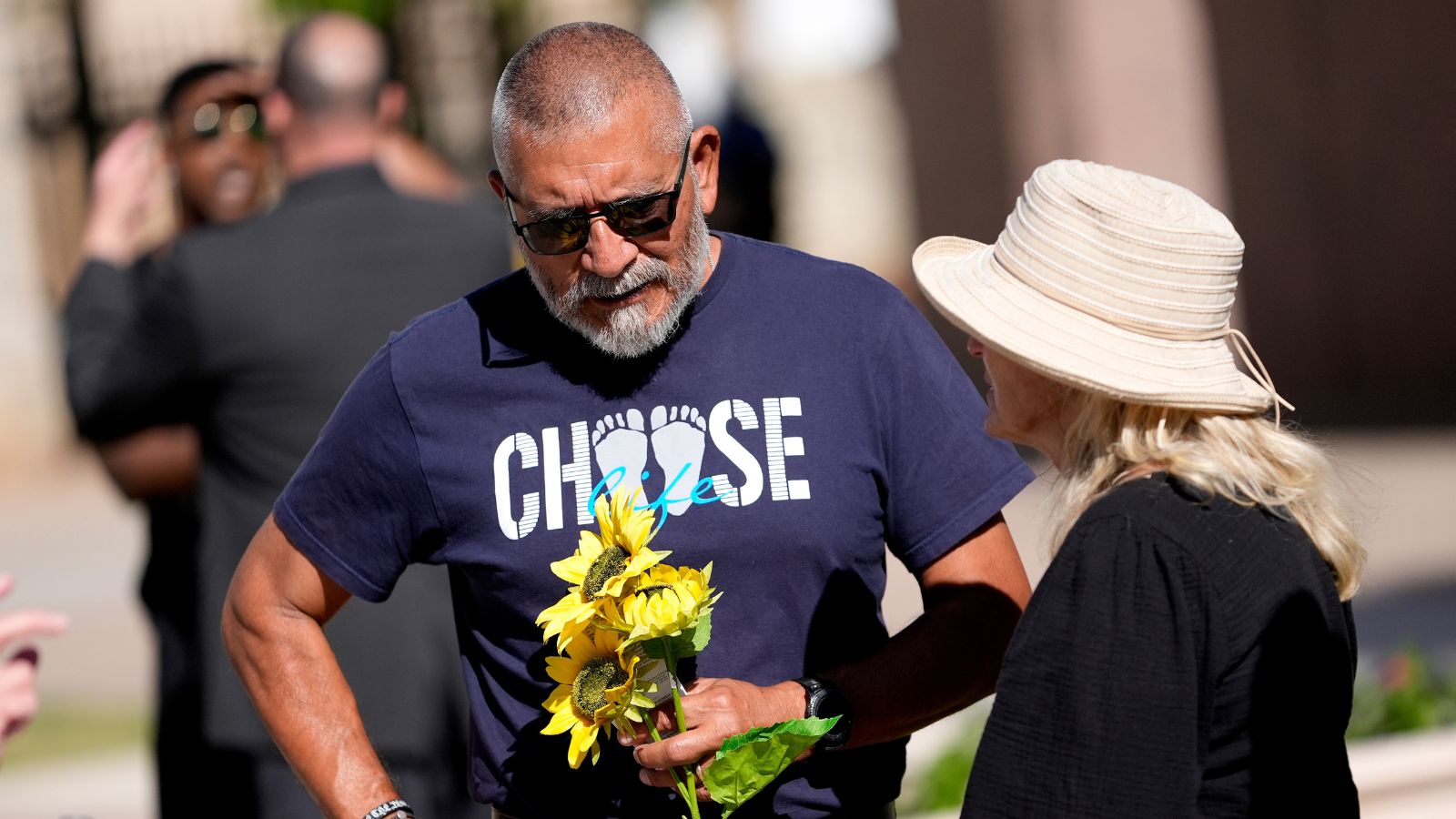What spiking US veterinary prices reveal about inflation
Oct 12, 2022, 7:08 AM | Updated: Oct 13, 2022, 4:09 am

Dr. Alexandra Kintz Konegger, of K. Vet Animal Care, examines a rescued Pekin Duck with an infected eye at her veterinary clinic in Greensburg, Pa., Tuesday, Oct. 11, 2022. Most pets hate visiting the vet. Now it's becoming a lot more unpleasant for their owners, too. America's worst bout of inflation in four decades has swollen the cost of your dog or cat's visit to the animal doctor.(AP Photo/Barry Reeger)
(AP Photo/Barry Reeger)
WASHINGTON (AP) — Most pets hate visiting the vet. Now it’s becoming a lot more unpleasant for their owners, too.
America’s worst bout of inflation in four decades has swollen the cost of your dog or cat’s visit to the animal doctor. Prices for vet services have jumped 10% in the past year, government data shows — the biggest such spike on records dating back two decades.
The surging cost of veterinary services illustrates how high inflation has spread well beyond physical goods, such as cars, that became scarce as the economy accelerated out of the pandemic recession, to numerous services of which pet care is one example. The trend has stoked fears that inflation is growing more entrenched and that the Federal Reserve will feel compelled to keep raising interest rates at an ever-higher risk of causing a recession.
From dental care and apartment rents to auto repairs and hotel rates, prices for services keep going up. Such inflation is especially hard to quell, because it’s driven mainly by a tight labor market and consumer demand, which won’t likely cool unless the economy slows drastically or sinks into a recession.
The cost of housing is the biggest driver of higher services prices. But even excluding rents, services prices rose 7.4% in August from a year ago.
The Fed’s rate hikes, which affect consumer and business loans, aren’t ideally suited to taming services inflation. And in today’s economy, the service sector accounts for the bulk of consumer spending.
“It takes more to move the prices of services,” said Joseph Gagnon, a former Fed official who is a fellow at the Peterson Institute for International Economics. “The real question is: What level of unemployment is going to be needed to cool off all this pressure?”
On Thursday, when the government issues consumer inflation data for September, it’s expected to report that prices jumped 8.1% from a year earlier. Though that would be down from an 8.3% jump in August, it would still far exceed Americans’ average wage gains.
Even as services grow costlier, goods inflation is slowing. Excluding volatile food and energy, price increases in goods have eased from a 12.4% annual rate in February to 7% in August. By contrast, services inflation has marched steadily higher, to a 6.1% annual rate from just 2.7% a year ago.
Spiking services prices are a big reason why Fed officials have stressed their determination to keep raising rates to move inflation back toward their 2% target, even as worries have grown that they’ll go too far and derail the economy.
Speaking last week, John Williams, president of the Federal Reserve Bank of New York, likened inflation to the layers of an onion, with goods representing the outer layers that are peeled first and services prices the stickier underlying layer.
“Therein lies our biggest challenge,” Williams said. “Prices for services have been rising at a fast rate. … And labor shortages are everywhere, leading to higher labor costs.”
Like many services, veterinary care is labor-intensive; worker pay makes up about half the cost of running a practice. With wages rising nationally at the fastest pace in decades, many clinic owners have had to pay more to find or keep employees. Those wage increases have typically been passed on to pet owners in the form of higher prices.
Other vet costs, including for medical supplies, lab testing fees and advanced pharmaceuticals, have accelerated, too.
The industry has also been transformed by corporate purchases of vet clinics and hospitals — a trend that some independent vets blame for increasing prices. The Federal Trade Commission has responded by forcing some large chains to cut back their acquisitions after concluding that they threatened competition.
Like many industries, veterinary care endured wrenching changes after the pandemic struck in 2020, driven by increased demand from pet owners and a shift in how they do business.
Alexandra Kintz-Konegger, who owns K.Vet Animal Care outside Pittsburgh, said the combination of more visits and the need to implement new protocols overwhelmed her staff. She soon lost eight employees, about a quarter of her workers.
“We were literally working tirelessly … just because the demand for our services had definitely increased and we were less effective,” she said.
Nationally, traffic at vet clinics rose 4.5% in 2020 and an additional 6.5% in 2021, according VetSuccess, a data analytics firm.
Yet at the same time, a survey by the American Veterinary Medical Association found that the number of pets that veterinarians treated per hour declined 25% in 2020. Such a steep drop in efficiency, combined with increased demand, left vets and their staffs burned out. Many left the field for other jobs.
Kintz-Konegger boosted wages 25% to 30% from pre-pandemic levels, which initially helped her replace many of the staffers she lost, only to see more departures. She’d still like to hire five more technicians and assistants.
Government data shows that hourly pay in the vet industry jumped 7% in August from a year earlier, well above the 5% average for all workers. Measured year over year, pay leapt 14.2% in January, the highest jump on records dating from 2007.
The cost of surgical supplies, medicines and lab tests are still increasing, too. Kintz-Konegger said her fees for blood tests and other lab work rose 8% both in January and August.
She passes those costs on to consumers and has raised her fee for a basic wellness exam 10% to $62. She also raised prices for sick and emergency visits.
“I feel very squeezed in the cost of services, cost of staff, cost of supplies,” she said. “It’s getting to a point where I’m going, ‘How much higher can this spiral before something gives here?’ “
Kintz-Konegger said she’ll probably have to raise prices again soon, unless her costs stop rising.
Across the economy, other services are skyrocketing, too. The cost of dental care spiked 1.9% just in June, the biggest one-month increase since record-keeping began in 1995, and 4.7% in August from a year earlier, the most in 14 years.
Auto insurance prices have been accelerating, a result of the big jump in vehicle prices since the pandemic. Pricier cars cost more to insure. And the price of medical care for people is also increasing, fueled largely by higher labor costs.
One factor in the rising cost of pet care is that it’s increasingly mimicking human health care. Specialty pet hospitals use MRI machines, expensive drugs have become available to fight cancer in pets and cats can receive kidney transplants. Vets and their technicians require advanced training to deliver such sophisticated services, which also can further inflate costs and the prices paid by consumers.
Many pet owners are increasingly willing to spend more, and large corporate providers of vet services are happy to cater to them. Though the industry began consolidating long before the pandemic, the pace has accelerated in the past two years.
John Volk, a senior consultant at Brakke Consulting, estimates that 25% of the 30,000 vet clinics in the United States are owned by large chains. The consolidation is much higher among the 1,200 emergency and specialty vet hospitals, about 75% of which are owned by chains.
Mars, the candy and pet food company, is the biggest owner of vet practices, with 2,500 clinics and hospitals worldwide. Another chain, National Veterinary Associates, owns 1,400 vet practices in the U.S. and overseas. It was acquired in 2020 by a Luxembourg-based private equity firm, JAB, and has recently come under scrutiny by the FTC.
In June, the FTC forced it to sell some vet hospitals in order to complete two new acquisitions. FTC Chair Lina Khan asserted that “serial acquisitions” by private equity firms and big corporations allow them “to accrue market power and reduce incentives to compete, potentially leading to increased prices and degraded quality.”
Some industry experts say larger chains can hold prices down by using their size to secure lower prices for supplies and drugs. How much the industry’s consolidation has contributed to higher costs is hotly debated within the vet industry, just as it is in the broader economy.
In the meantime, many vets are still looking to hire, a sign that the inflationary pressure from rising wages may take a long time to ease.
“We still don’t have enough veterinarians to handle all the demand that’s out there,” said Michelle Vitulli, who owns eight vet clinics in Northern Virginia and Maryland.
Copyright © The Associated Press. All rights reserved. This material may not be published, broadcast, rewritten or redistributed.











